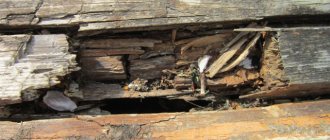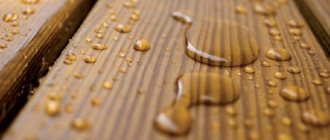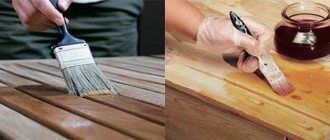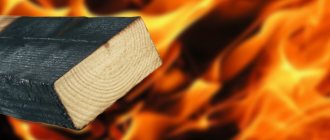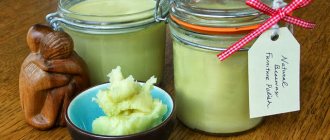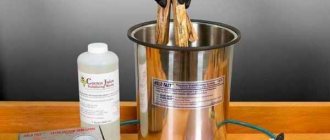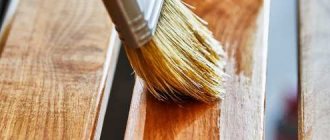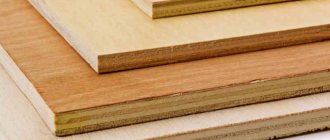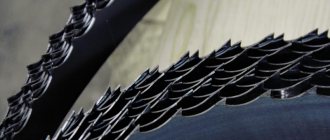Wood is considered the most environmentally friendly building material. Most often used in repair and construction work. Due to the pronounced decorative effect, residential premises are finished with wood. However, wooden surfaces must be treated so that the material does not begin to deteriorate and rot. Hand-crafted wood processing can be done using synthetic products or solutions prepared according to folk recipes.
What and when to protect wood from?
Wood surfaces must be treated so that external adverse influences do not harm the product. The list of factors that have a detrimental effect on the durability of wood includes:
- Excessive indoor humidity, foggy and rainy weather. Wood absorbs moisture and swells. As a result of temperature fluctuations, cracks often form on the surface of products.
- mold and fungal deposits, moss, insect damage. A favorable condition for their spread is waterlogging combined with limited air access. In addition to the fact that due to rotting, the growth of moss or the spread of insect pests, the appearance of the tree deteriorates, the structure of the material is also deformed.
- fiery influence. Wood is highly flammable and burns quickly.
- ultraviolet. The duration of this action leads to fading and acquiring a gray tint.
Causes and signs of pest appearance
The main reason for its appearance is the use of low-quality wood that has not been treated with impregnations against borer beetles. Over time, the protective layer loses its properties. During the mating period, beetles fly to other wooden structures and make new clutches. It is necessary to periodically inspect surfaces and protect wood from woodworms. Impregnate periodically with a new layer of insecticides.
Signs of the appearance of grinder beetles:
- small holes on the surface of wooden structures, furniture; the appearance of wooden pollen, similar in color to mustard powder; rustling, tapping inside the solid wood in the evening, at night; a characteristic odor from insect secretions, insect pheromones; if you remove the outer layer, you can see grooves , larval passages.
You need to start exterminating beetles immediately, as soon as the first signs appear.
Tap the wood, the sound is different. In a healthy tree it is dull, in a damaged tree it is louder, due to the presence of voids. Pollen will begin to fall out of small tree holes.
General principles for choosing wood preservatives
When selecting a preparation for treatment that will protect wood, experts recommend focusing on the following criteria:
- durability of the layer. If you impregnate wooden products with this coating, it will last about four years. If the manufacturer guarantees a thirty-year service life, these products should be purchased with special caution.
- consumption of protective agent. A budget solution will likely require high consumption. Such products cannot be called economical. On average, the consumption of bioprotective agent is 230 g/m2.
- name of the manufacturer. The production of high-quality compositions is carried out by factory enterprises that have modern equipment and technological devices. However, such products will cost more.
- versatility of purpose. The complex preparation for impregnation provides protection of the wooden surface from burning and the occurrence of putrefactive lesions. However, the effectiveness of a solution that combines several potent substances is significantly reduced.
- what the drug consists of, product certification. The base may consist of components of organic and inorganic origin. A number of inorganic compounds are harmful to human health and are prohibited in many European countries. Organic-based solutions are more effective and are considered relatively safe. All products of this type must be certified.
Rating of the best wood impregnations
| Nomination | place | Name of product | rating |
| The best wood impregnation for interior work | 1 | Pinotex Interior | 4.9 |
| 2 | Tikkurila Supi | 4.8 | |
| 3 | Aquatex Rogneda Extra | 4.8 | |
| 4 | NEOMID 430 ECO | 4.7 | |
| 5 | Tex Biotex Classic Universal | 4.7 | |
| 6 | Extra Aquatex with wax | 4.6 | |
| 7 | Ecohouse | 4.5 | |
| The best wood impregnation for outdoor use | 1 | Tikkurila Eko Wood | 4.9 |
| 2 | Luxens | 4.8 | |
| 3 | Pinotex Ultra | 4.8 | |
| 4 | EXTREME CLIMATE | 4.7 | |
| 5 | Dufa Wood Protect | 4.7 | |
| 6 | Nortex-Disinfector | 4.6 | |
| The best fire retardant impregnations for wood | 1 | NEOMID 450 | 4.9 |
| 2 | Senezh Ognebio Prof | 4.8 |
Wood protection methods
A set of measures to help ensure long-term preservation of wood includes:
- creating a competent layout;
- constant monitoring of the condition of the wooden surface;
- use of properly selected protective equipment.
Currently, modern types of technologies for applying preparations for the chemical treatment of wood are used:
- antiseptic. It consists of surface treatment of the board where the paint will be applied. For coating, impregnation with a brush is used.
- canning. A method used in industrial construction. The treatment is carried out under high pressure or kept in heated and cool baths.
Products for protecting wood from moisture
The consequences of keeping a tree in conditions of excessive waterlogging are:
- reduction in performance properties;
- spread of mold outbreaks;
- the appearance of fungus.
There are several types of exposure to humidity:
- rain and snow precipitation;
- formed condensate;
- moisture coming from a specific source.
Protection from wood moisture is ensured even at the procurement stage. It should be noted that different types of wood react differently to humidity. The most stable in terms of this parameter are:
- larch;
- ash;
- pine;
- oak.
Wood that is moderately resistant to waterlogging:
- spruce;
- fir;
- beech.
Some types of tropical wood require little or no processing.
Wood varieties differ in the level of intracellular moisture. In the construction industry, raw materials with an indicator of approximately 15% can be used. The recommended humidity of the material used to create the truss structure is about 13%. External cladding requires the selection of raw materials with fifteen percent moisture content.
It is possible to reduce hygroscopicity using several types of means to protect wood from moisture:
- varnishes;
- oil compositions;
- paste
Solutions that form a film coating cannot be called durable. Because of this, there is a need for regular processing. Penetrating formulations, on the contrary, provide a longer lasting effect. Walls of residential buildings and garden furniture are treated with such preparations.
The use of a water repellent does not distort the shade. The coating layer is able to protect the building material, preventing liquid from penetrating into the structure. Often this type of solution can provide good frost resistance.
How does the process of rotting wooden structures start?
Biological decay of wood occurs both in the presence of one of the following reasons, and in a combination of them:
- The material’s own moisture content exceeds 15%
- access of oxygen to wooden parts
- warm and humid climate
- high humidity in the storage area
- multiple freeze/defrost cycle
- sudden changes in temperature
- the appearance and physical qualities of the tree.
These factors create conditions for the development of parasitic fungi, which trigger the process of wood rotting.
If storage conditions are violated, end cuts of fresh logs and entire stacks of lumber may suffer from post and warehouse fungi, which outwardly resemble mold.
Building materials and finished wooden structures are susceptible to damage from house fungi if the installation technology was violated, special protective equipment was not used, or safety precautions were not followed during operation.
The destructive process begins from the outer layers. Gradually, the parasite penetrates and destroys the tree.
Products for protecting wood from rot, mold and insects
The most effective preventive measure against mold is the use of antiseptics. However, such protective drugs do not destroy microorganisms, but only prevent their appearance and further spread. Coating the wood with an antiseptic is performed at the manufacturing stage. The raw materials are processed again using the same technology after the stripping is completed. An antiseptic is a liquid solution or paste-like preparation that protects the product from insect pests. The antiseptic primer, which contains lime, has a short service life. It is applied under the varnish layer.
If there are traces of putrefaction, before applying an antiseptic layer to treat wood from rotting, it is treated with a fungicide. This is a substance that destroys fungal and mold spores. Depending on the main components, products of this type can be divided into:
- water soluble. Such fungicides based on sodium fluoride, silicofluoride, borax and boric acid are considered the most inexpensive and environmentally friendly. However, over time, they are gradually washed out. Thus, water-soluble fungicides are suitable for treating rot and moisture on the inside of wood products.
- White Spirit. Resistant to environmental influences, not susceptible to washing out. Among the disadvantages is a pungent odor, which complicates the process of creating protection for wood from rotting.
If the building material shows signs of damage by insects, treatment with insecticides is required. They come in two types:
- water based. With their help, year-long protection is provided during transportation and storage.
- alkyd based. They are resistant and can be applied for preventive purposes.
To prevent the process of wood rotting, you should check the surface for the presence of a putrid odor and brown films.
To remove black and greenish stains, bleaching agents are used. A small amount of this composition is applied to the damaged area using a brush, after which after some time the shade returns to its original state.
Absorbency of different breeds
The following tree species have the highest degree of absorption:
- birch;
- beech.
The compounds that absorb the worst are:
- spruce;
- fir.
When treating a house made of timber from the outside
The first treatment of wooden houses is carried out before construction.
This is usually done by immersing the logs in a bath of antiseptic solution. But, as a rule, lumber undergoes primary processing under production conditions. If construction is not planned immediately after transportation, it is necessary to ensure proper storage of the timber. Lumber should be stored in a well-ventilated and dry room or under a canopy, in a place where the timber does not come into contact with the ground.
The second treatment of a timber house is carried out within a few days after completion of construction. It is necessary to use water-soluble compounds that do not interfere with the natural shrinkage that occurs in the wood. The air temperature during processing should be at least 5-7 degrees Celsius. If a log house is erected in winter, when all natural processes freeze (including the activity of microorganisms and insects), processing can be postponed until spring.
After the completion of the shrinkage processes, the third treatment of the house frame is carried out. The exact time depends on the type of lumber and the moisture content of the wood. Processing of imitation timber and laminated timber, materials that have undergone chamber drying, can be carried out immediately after construction. Treatment of a house made of profiled timber can be carried out no earlier than in a year and a half, when the moisture content of the lumber reaches 20%.
Means for protecting wood from fire
A massive log takes longer to burn compared to a thin board. Smoldering of the charred layer occurs slowly. The presence of chips and cracks makes the surface of the log vulnerable to fire. The fire retardant delays the process of ignition and spread of fire.
Fire retardant can be produced in the following forms:
- liquid (varnish for decorative finishing, enamel, paint);
- solid (backfill, coating composition).
Useful information: Just a few years ago, a treatment agent such as a fire retardant was extremely hard. Using the drug in the form of a ready-made liquid concentrate is more effective. When working with powders, it will not be possible to completely avoid toxic fumes entering the body.
All flame retardants can be divided into:
- active, created on the basis of salts of phosphoric and boric acids. Elevated temperatures contribute to their melting, resulting in the formation of a protective layer that retards the spread of fire;
- passive, capable of creating a thin layer that reflects heat from the wooden surface. When overheated, swelling occurs, slowing down the spread of fire.
The highest quality fire-resistant coating is applied in industrial conditions. However, this type of processing can be carried out manually - with a brush, roller or aerosol. Small-sized products can be processed by immersing them in concentrate for several hours.
Stages of log processing
Before impregnating the timber with protective compounds, it is necessary to carry out preliminary surface preparation.
If you are treating an old house, you first need to brush the walls to remove dirt and dust. Then, using coarse sandpaper, remove the previous paintwork, blue areas of wood and fungal formations. Next, the surface is sanded. For a fresh log house, this operation is the first. Sanding is necessary to remove visual defects and for better and deeper penetration of impregnating compounds into the wood.
Processing is performed in the following sequence:
- Impregnation of wood with antiseptic solutions. Impregnation for a wooden house must be applied to the main surface in 2-3 layers, the ends of the logs must be treated at least 4-5 times. Each new layer is applied after the previous one has dried, usually the solution dries for about a day.
- Fire retardant treatment. Fire retardants are applied in 2-3 layers approximately 10 days after antiseptic treatment.
- Surface priming. A primer is necessary to save paint and better adhesion of the dye to the wooden surface.
- Finishing is carried out within two months after processing. It is recommended to adhere to these deadlines; if you paint the log house later, the protective compounds may be washed away by precipitation, and the house will be left unprotected.
Experts advise not to violate the recommended processing order; if you perform work in a different sequence, it is impossible to ensure high-quality and reliable protection of the wood.
It must also be remembered that after treatment, the wood becomes protected only for a certain time; no product guarantees eternal protection of the wood. Treatments must be carried out regularly; the outer surfaces of a wooden house must be impregnated with antiseptics every five to seven years.
Products for protecting wood from ultraviolet radiation
Prolonged exposure to ultraviolet radiation leads to darkening and deformation of the structure. If the building material is regularly exposed to UV radiation, preventing negative consequences in this case is a mandatory measure.
Depending on the purpose, products of this type are:
- primers (base solutions, oils);
- finishing (paint and varnish and oil essences).
In addition, drugs against ultraviolet rays are divided into:
- providing initial protection;
- medicinal.
An additive for treating wood against ultraviolet radiation can be included in the composition of bioprotective preparations and paint and varnish essences. In this case, you can find the corresponding designation on the packaging.
Sequence of application of protective agents
To get a long-lasting result, the protective composition should be applied following the recommended sequence:
- treatment with an antiseptic at the stage of procurement and transportation, upon completion of the assembly of furniture fittings and other structures made of lumber;
- fire retardant (if required);
- moisture repellent;
- paint and varnish composition with UV protection on all external areas;
- acrylic sealant.
Wooden raw materials can be processed using several technologies. The building materials market offers a wide range of different compositions - on organic and chemical bases. To properly process wood, you should carefully select a protective agent and be careful when working with materials.
Classification of drugs
A large number of available antiseptics have been developed that are used for treating wood and have a surface and deep effect. The most common inorganic, organic and combined antiseptics are:
- Inorganic mixtures are the least toxic and are widely used in private households. These include sodium fluoride and fluoride salts, alkali metal chromates and dichromates, copper sulfate, a mixture of boric acid and its sodium derivative - borax. The list of inorganic antiseptics is wide and depends on specific tasks, local characteristics and weather conditions.
- Organic antiseptics are resins that are predominantly coke-chemical in nature, heavy insecticides (protection against insects) and fungicides (stop the growth of fungus). Such mixtures are used for processing industrial structures and are rarely used in agriculture due to significant toxicity. Less harmful impregnations containing gasoline and turpentine components can be used for external protection of residential buildings.
- Combined antiseptics are mixtures of solvents and target components (resins, insecticides, fungicides). The resulting mixtures are often no less dangerous than their individual organic components, and therefore are rarely used in everyday life. Most often in production when splicing wood. The development of chemical and environmental production has led to the emergence of new varieties of commercial drugs that are less harmful to humans and the environment.
The photo shows different types of antiseptics
Organic
Inorganic
Combined
Hard to wash out
